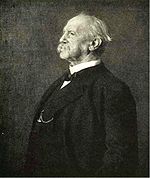Oscar Montelius
| Oscar Montelius | |
|---|---|

Oscar Montelius, painted by Emerik Stenberg (Photo of painting from the Swedish periodical Ord & Bild 1913)
|
|
| Born | 9 September 1843 |
| Died | 4 November 1921 (aged 78) Stockholm |
| Nationality | Swedish |
| Fields | archaeology |
| Known for | seriation |
| Notable awards |
Pour le Mérite for Sciences and Arts (1898) Anders Retzius Medal (1913) |
Gustav Oscar August Montelius, known as Oscar Montelius (9 September 1843 – 4 November 1921) was a Swedish archaeologist who refined the concept of seriation, a relative chronological dating method.
Oscar Montelius refined the concept of seriation, a relative chronological dating method. Seriation is the procedure of working out a chronology by arranging material remains of a cultural tradition in the order that produces the most consistent patterning of their cultural traits.
His impetus was at first to provide relative dates for artifacts in museum collections that often lacked rigorous records, by making comparisons with other artifacts within a comparable geographical area. Montelius’ method created a timeline specific to the location, based on material remains. Later, when combined with written historical references, objects could be provided absolute dates.
He took the three-age system (Stone Age, Bronze Age, Iron Age), originally devised by Christian Jürgensen Thomsen to organize Danish museum collections of archaeological materials, and sub-divided it further. He divided the Neolithic in Scandinavia into four numbered periods, I-IV, and the Nordic Bronze Age into six I-VI. He was the first to establish that the numerous Swedish petroglyphs were from the Nordic Bronze Age, by comparing axes portrayed in the petroglyphs with archaeological finds. Further he supported Thomsen's typology of gold bracteates from the migration period.
By taking calendrical dates from the recently deciphered hieroglyphics of Ancient Egypt, Montelius employed a complex system of cross-dating through typologies and associated finds to apply absolute dates to archaeological finds and features all over Europe.
...
Wikipedia
